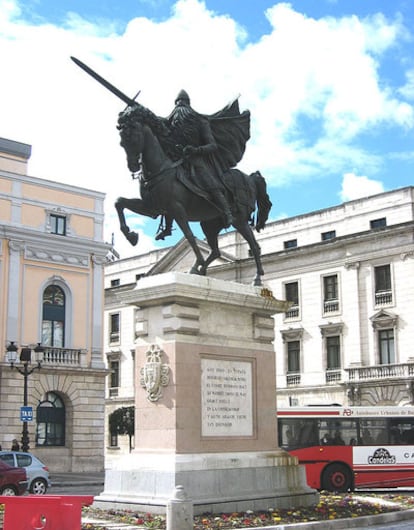The fight for El Cid’s sword, worth “a thousand gold marks”
Lawsuit lays down ownership claim on the supposed sword of the medieval hero
In this case it would be hard to apply the judgment of Solomon. Litigation is now under way for an unusual legacy, as prized as it is indivisible: a sword 93 centimeters long by some 4.5 centimeters broad, believed to be the sword Tizona, which belonged to the medieval hero Rodrigo Díaz de Vivar, aka El Cid (1043-1099).
Though the hilt on the sword (which is, in the words of the epic poem Cantar de Mio Cid, "worth a thousand marks of gold") is more recent, authorities on old steel consider that this blade was indeed made in the 11th century, probably in Seville. So there is no reason it might not have actually been wielded by the noble knight El Cid. At any rate, such has been its reputation for centuries.
The sword was no display at the Army Museum in Madrid, until a few years ago
A recent lawsuit filed at Magistrate's Court no. 72 in the Plaza de Castilla in Madrid demands a share of the blade's monetary value. The plaintiffs are Mercedes and Olga, the heirs of Salustiano Fernández, a former fisherman who cared for the blind Pedro Velluti y Murga, 15th marquess of Falces, the owner of the sword. Centuries ago, Tizona had been bequeathed to his ancestor, Antonio Carrillo de Peralta, the second marquess of Falces, by Ferdinand the Catholic, consort of Isabella queen of Castile, and in his own right king of Aragon. This gift rewarded Carrillo's mediation in the successful incorporation of the Kingdom of Navarre into Spain (for it was also claimed by France).
Ferdinand had inherited the sword in a chain of succession that went back to the daughters of El Cid, who had both married counts of Catalonia, then linked to the crown of Aragon.
'Tizona' was sold to the government of Castilla y León for around 1.7 million euros
The 15th marquess made Salustiano his sole heir. He owned the sword jointly with his sister Olga (not the same as above), marquise of Cerro de la Cabeza. In a 1980 notary's paper, both jointly decided to lend the sword to the Army Museum in Madrid, where it was on display from 1944 until a few years ago. The marquess died leaving Salustiano as his sole heir. The former fisherman later died, and his heirs now consider that the co-ownership of the antiquity was bequeathed to them, and are claiming their share. The point, and problem, is that Olga's heir, José Ramón Suárez de Otero Velluti, now resident in Israel, sold Tizona to the regional government of Castilla y León in 2008, for a price that informed sources put at between 1.6 and 1.7 million euros.
The sword is now on display in Burgos, where it arrived without the knowledge of the other heirs. Sources close to them consider that the sword should return to Madrid, and if this is not possible, demand half of the price paid to Suárez de Otero. Sources close to the latter decline to comment. The law says that if a testator has no living ancestors, descendants or spouse - and this was the marquess' case - he can designate as heir whomever he wishes.

Tu suscripción se está usando en otro dispositivo
¿Quieres añadir otro usuario a tu suscripción?
Si continúas leyendo en este dispositivo, no se podrá leer en el otro.
FlechaTu suscripción se está usando en otro dispositivo y solo puedes acceder a EL PAÍS desde un dispositivo a la vez.
Si quieres compartir tu cuenta, cambia tu suscripción a la modalidad Premium, así podrás añadir otro usuario. Cada uno accederá con su propia cuenta de email, lo que os permitirá personalizar vuestra experiencia en EL PAÍS.
¿Tienes una suscripción de empresa? Accede aquí para contratar más cuentas.
En el caso de no saber quién está usando tu cuenta, te recomendamos cambiar tu contraseña aquí.
Si decides continuar compartiendo tu cuenta, este mensaje se mostrará en tu dispositivo y en el de la otra persona que está usando tu cuenta de forma indefinida, afectando a tu experiencia de lectura. Puedes consultar aquí los términos y condiciones de la suscripción digital.
Archived In
Últimas noticias
The complicated life of Francesca Albanese: A rising figure in Italy but barred from every bank by Trump’s sanctions
Half of Scotland is in the hands of 420 property owners
Pinochet’s victims grapple with José Antonio Kast’s rise in Chile
Reinhard Genzel, Nobel laureate in physics: ‘One-minute videos will never give you the truth’
Most viewed
- Pablo Escobar’s hippos: A serious environmental problem, 40 years on
- Why we lost the habit of sleeping in two segments and how that changed our sense of time
- Charles Dubouloz, mountaineering star, retires at 36 with a farewell tour inspired by Walter Bonatti
- Reinhard Genzel, Nobel laureate in physics: ‘One-minute videos will never give you the truth’
- The Florida Keys tourist paradise is besieged by immigration agents: ‘We’ve never seen anything like this’








































